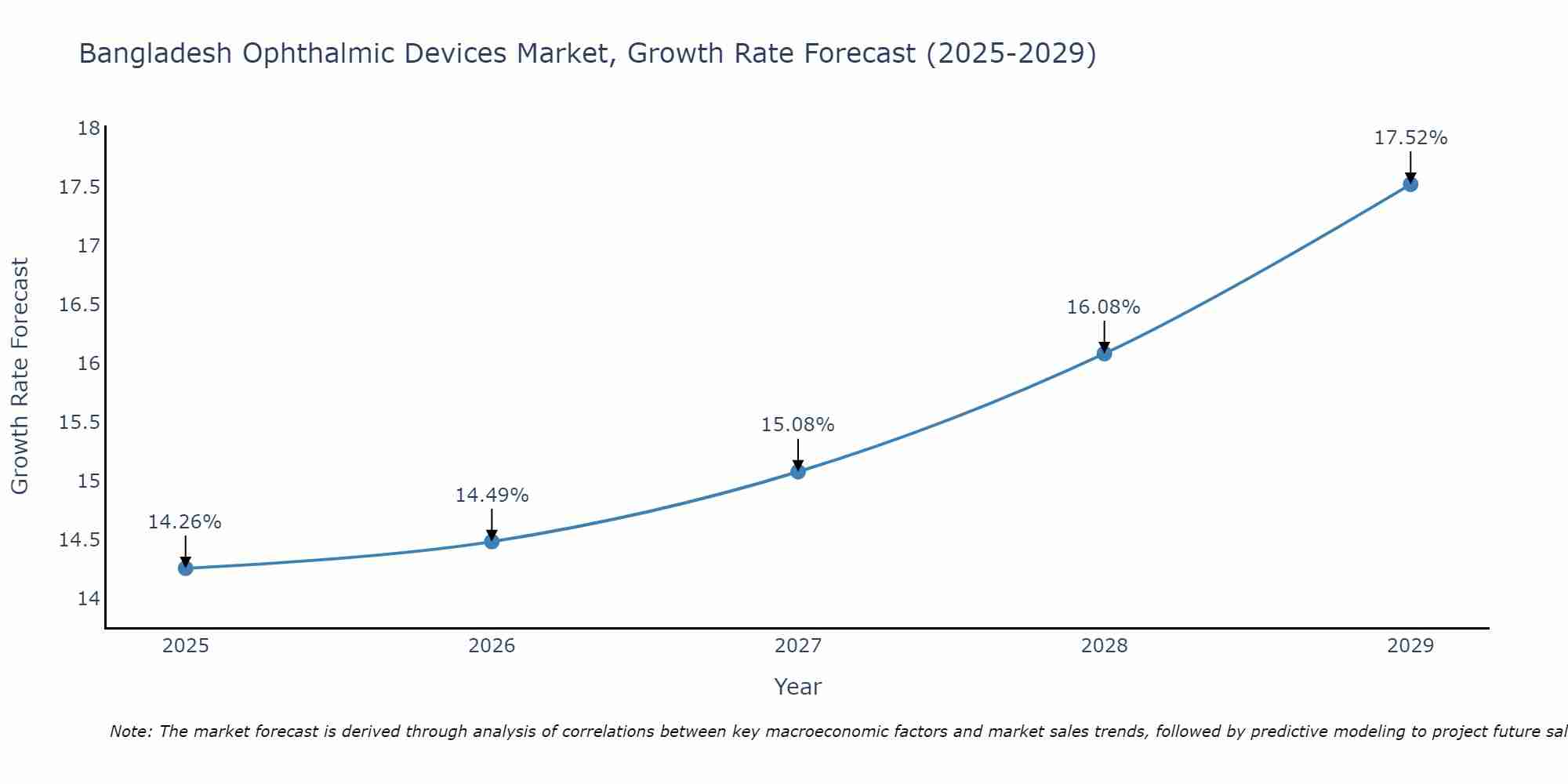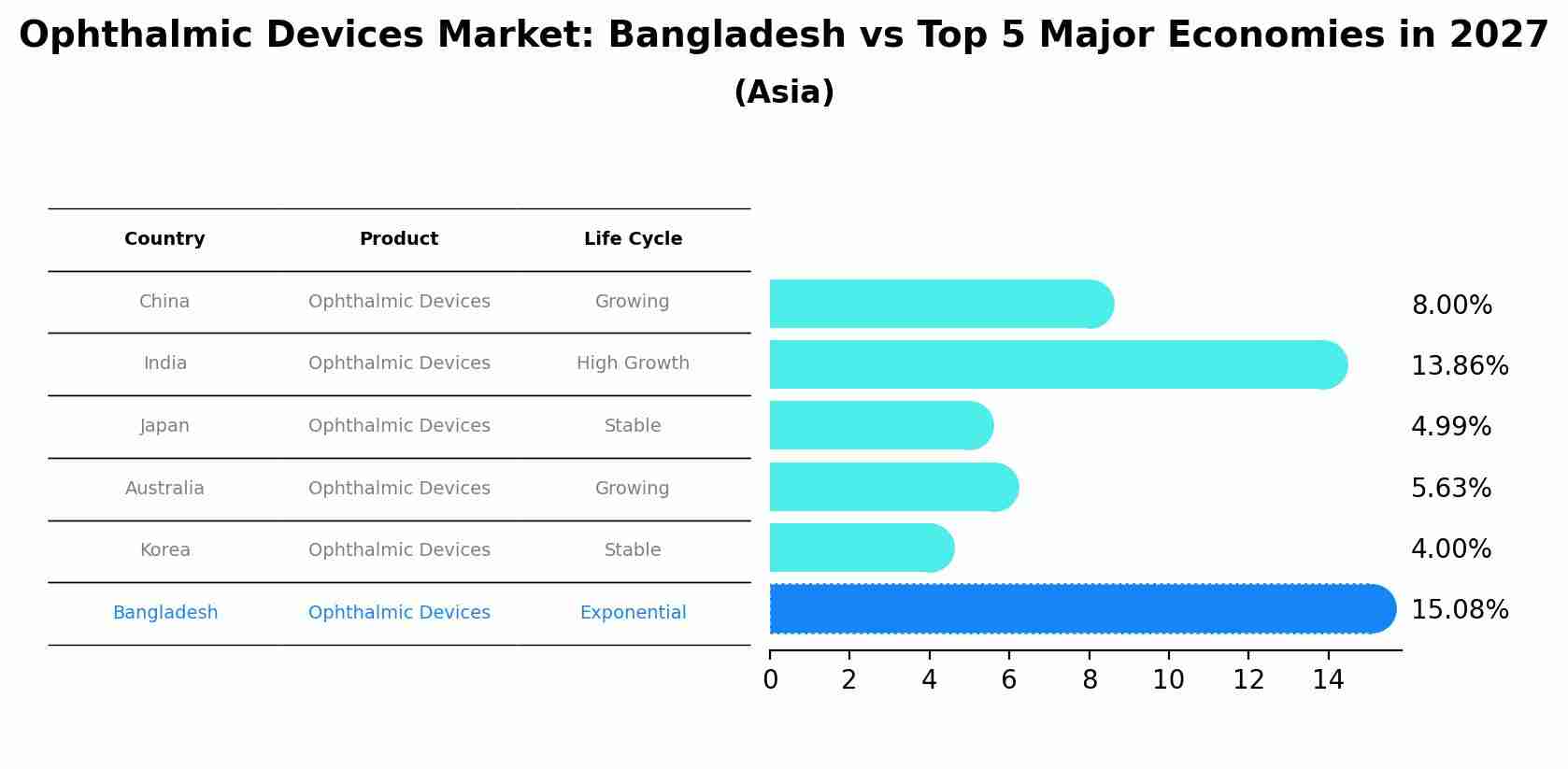Bangladesh Ophthalmic Devices Market (2025-2031) Outlook | Analysis, Trends, Revenue, Growth, Share, Industry, Companies, Value, Size & Forecast
| Product Code: ETC367892 | Publication Date: Aug 2022 | Updated Date: Jul 2025 | Product Type: Market Research Report | |
| Publisher: 6Wresearch | Author: Summon Dutta | No. of Pages: 75 | No. of Figures: 35 | No. of Tables: 20 |
Bangladesh Ophthalmic Devices Market Size Growth Rate
The Bangladesh Ophthalmic Devices Market is likely to experience consistent growth rate gains over the period 2025 to 2029. Commencing at 14.26% in 2025, growth builds up to 17.52% by 2029.

Ophthalmic Devices Market: Bangladesh vs Top 5 Major Economies in 2027 (Asia)
The Ophthalmic Devices market in Bangladesh is projected to grow at a exponential growth rate of 15.08% by 2027, highlighting the country's increasing focus on advanced technologies within the Asia region, where China holds the dominant position, followed closely by India, Japan, Australia and South Korea, shaping overall regional demand.

Bangladesh Ophthalmic Devices Market Synopsis
The Bangladesh Ophthalmic Devices Market is experiencing steady growth driven by factors such as increasing prevalence of eye disorders, a growing aging population, and a rise in awareness about eye health. The market includes various segments such as diagnostic devices, surgical devices, and vision care products. Key players in the market offer a wide range of products including ophthalmic diagnostic equipment, intraocular lenses, and surgical instruments. Government initiatives to improve healthcare infrastructure and accessibility to eye care services are further fueling market growth. However, challenges such as limited healthcare budget, lack of skilled professionals, and inadequate healthcare facilities in rural areas pose obstacles to market expansion. Overall, the Bangladesh Ophthalmic Devices Market presents opportunities for innovation and collaboration to meet the evolving needs of the population.
Bangladesh Ophthalmic Devices Market Trends
The Bangladesh Ophthalmic Devices Market is experiencing a shift towards advanced technologies and minimally invasive procedures. There is a growing demand for premium intraocular lenses, optical coherence tomography devices, and femtosecond lasers for cataract and refractive surgeries. The market is also witnessing an increased adoption of digital imaging systems for accurate diagnosis and treatment planning. With a rising prevalence of eye disorders and an aging population, there is a heightened focus on early detection and management of eye conditions, driving the demand for innovative ophthalmic devices. Additionally, collaborations between healthcare providers and industry players are promoting the development of customized solutions tailored to the specific needs of the Bangladeshi population, further fueling market growth.
Bangladesh Ophthalmic Devices Market Challenges
The Bangladesh Ophthalmic Devices Market faces several challenges, including limited access to quality eye care services in remote areas, lack of awareness about eye health, and affordability issues for advanced ophthalmic devices. Infrastructure constraints, such as inadequate healthcare facilities and trained professionals, also hinder the market`s growth. Additionally, regulatory hurdles and import restrictions on medical devices pose challenges for manufacturers and distributors operating in the market. The presence of counterfeit products further exacerbates the situation, impacting patient safety and market credibility. Overall, addressing these challenges will require collaborative efforts from government bodies, healthcare providers, industry stakeholders, and non-profit organizations to improve eye care accessibility, affordability, and quality in Bangladesh.
Bangladesh Ophthalmic Devices Market Investment Opportunities
The Bangladesh Ophthalmic Devices Market presents several investment opportunities due to the country`s increasing focus on improving healthcare infrastructure and the rising prevalence of eye-related disorders. Key areas for investment include advanced diagnostic equipment such as optical coherence tomography (OCT) machines, phacoemulsification systems for cataract surgery, and intraocular lenses. Additionally, there is growing demand for innovative surgical instruments, including vitrectomy systems and laser devices for procedures like refractive surgery. Expanding access to quality eye care services in both urban and rural areas further drives the need for investments in portable and cost-effective devices. Collaborating with local healthcare providers and institutions to introduce cutting-edge technologies and training programs can position investors for long-term growth in the Bangladesh Ophthalmic Devices Market.
Jordan Agar Market Government Policies
In Bangladesh, the government has implemented policies to regulate the ophthalmic devices market. The Directorate General of Drug Administration (DGDA) is responsible for overseeing the registration, importation, and marketing of ophthalmic devices to ensure safety, quality, and efficacy. Companies looking to introduce new ophthalmic devices into the market must obtain approval from the DGDA by submitting necessary documentation and meeting regulatory requirements. Additionally, the government has been focusing on promoting local manufacturing of ophthalmic devices through incentives and support to reduce dependency on imports and enhance domestic production capabilities. These policies aim to safeguard public health, encourage innovation, and develop the local ophthalmic devices industry in Bangladesh.
Bangladesh Ophthalmic Devices Market Future Outlook
The Bangladesh Ophthalmic Devices Market is expected to witness steady growth in the coming years due to various factors such as an increasing prevalence of eye disorders, a growing elderly population, and rising awareness about eye health. Technological advancements in ophthalmic devices, such as advanced diagnostic tools and innovative surgical equipment, will further drive market growth. Additionally, government initiatives to improve healthcare infrastructure and accessibility to eye care services will contribute to market expansion. With the increasing demand for ophthalmic devices for diagnosis, treatment, and management of eye diseases, the market is poised for continuous growth and innovation in the foreseeable future.
Key Highlights of the Report:
- Bangladesh Ophthalmic Devices Market Outlook
- Market Size of Bangladesh Ophthalmic Devices Market, 2024
- Forecast of Bangladesh Ophthalmic Devices Market, 2031
- Historical Data and Forecast of Bangladesh Ophthalmic Devices Revenues & Volume for the Period 2021 - 2031
- Bangladesh Ophthalmic Devices Market Trend Evolution
- Bangladesh Ophthalmic Devices Market Drivers and Challenges
- Bangladesh Ophthalmic Devices Price Trends
- Bangladesh Ophthalmic Devices Porter's Five Forces
- Bangladesh Ophthalmic Devices Industry Life Cycle
- Historical Data and Forecast of Bangladesh Ophthalmic Devices Market Revenues & Volume By Product for the Period 2021 - 2031
- Historical Data and Forecast of Bangladesh Ophthalmic Devices Market Revenues & Volume By Optical Coherence Tomography Scanners for the Period 2021 - 2031
- Historical Data and Forecast of Bangladesh Ophthalmic Devices Market Revenues & Volume By Fundus Cameras for the Period 2021 - 2031
- Historical Data and Forecast of Bangladesh Ophthalmic Devices Market Revenues & Volume By Perimeters/Visual Field Analyzers for the Period 2021 - 2031
- Historical Data and Forecast of Bangladesh Ophthalmic Devices Market Revenues & Volume By Autorefractors and Keratometers for the Period 2021 - 2031
- Historical Data and Forecast of Bangladesh Ophthalmic Devices Market Revenues & Volume By Ophthalmic Ultrasound Imaging Systems for the Period 2021 - 2031
- Historical Data and Forecast of Bangladesh Ophthalmic Devices Market Revenues & Volume By Ophthalmic Pachymeters for the Period 2021 - 2031
- Historical Data and Forecast of Bangladesh Ophthalmic Devices Market Revenues & Volume By Tonometers for the Period 2021 - 2031
- Historical Data and Forecast of Bangladesh Optical Coherence Tomography Scanners Ophthalmic Devices Market Revenues & Volume By Slit Lamps for the Period 2021 - 2031
- Historical Data and Forecast of Bangladesh Ophthalmic Devices Market Revenues & Volume By Application for the Period 2021 - 2031
- Historical Data and Forecast of Bangladesh Ophthalmic Devices Market Revenues & Volume By Cataract for the Period 2021 - 2031
- Historical Data and Forecast of Bangladesh Ophthalmic Devices Market Revenues & Volume By Vitreo retinal disorders for the Period 2021 - 2031
- Historical Data and Forecast of Bangladesh Ophthalmic Devices Market Revenues & Volume By Glaucoma for the Period 2021 - 2031
- Historical Data and Forecast of Bangladesh Ophthalmic Devices Market Revenues & Volume By Refractor Disorders for the Period 2021 - 2031
- Historical Data and Forecast of Bangladesh Ophthalmic Devices Market Revenues & Volume By End-use for the Period 2021 - 2031
- Historical Data and Forecast of Bangladesh Ophthalmic Devices Market Revenues & Volume By Hospitals and Eye Clinics for the Period 2021 - 2031
- Historical Data and Forecast of Bangladesh Ophthalmic Devices Market Revenues & Volume By Academic and Research Laboratory for the Period 2021 - 2031
- Historical Data and Forecast of Bangladesh Ophthalmic Devices Market Revenues & Volume By Others for the Period 2021 - 2031
- Bangladesh Ophthalmic Devices Import Export Trade Statistics
- Market Opportunity Assessment By Product
- Market Opportunity Assessment By Application
- Market Opportunity Assessment By End-use
- Bangladesh Ophthalmic Devices Top Companies Market Share
- Bangladesh Ophthalmic Devices Competitive Benchmarking By Technical and Operational Parameters
- Bangladesh Ophthalmic Devices Company Profiles
- Bangladesh Ophthalmic Devices Key Strategic Recommendations
Frequently Asked Questions About the Market Study (FAQs):
- Single User License$ 1,995
- Department License$ 2,400
- Site License$ 3,120
- Global License$ 3,795
Search
Thought Leadership and Analyst Meet
Our Clients
Related Reports
- Canada Oil and Gas Market (2026-2032) | Share, Segmentation, Value, Industry, Trends, Forecast, Analysis, Size & Revenue, Growth, Competitive Landscape, Outlook, Companies
- Germany Breakfast Food Market (2026-2032) | Industry, Share, Growth, Size, Companies, Value, Analysis, Revenue, Trends, Forecast & Outlook
- Australia Briquette Market (2025-2031) | Growth, Size, Revenue, Forecast, Analysis, Trends, Value, Share, Industry & Companies
- Vietnam System Integrator Market (2025-2031) | Size, Companies, Analysis, Industry, Value, Forecast, Growth, Trends, Revenue & Share
- ASEAN and Thailand Brain Health Supplements Market (2025-2031) | Strategy, Consumer Insights, Analysis, Investment Trends, Opportunities, Growth, Size, Share, Industry, Revenue, Segments, Value, Segmentation, Supply, Forecast, Restraints, Outlook, Competition, Drivers, Trends, Demand, Pricing Analysis, Competitive, Strategic Insights, Companies, Challenges
- ASEAN Bearings Market (2025-2031) | Strategy, Consumer Insights, Analysis, Investment Trends, Opportunities, Growth, Size, Share, Industry, Revenue, Segments, Value, Segmentation, Supply, Forecast, Restraints, Outlook, Competition, Drivers, Trends, Demand, Pricing Analysis, Competitive, Strategic Insights, Companies, Challenges
- Europe Flooring Market (2025-2031) | Outlook, Share, Industry, Trends, Forecast, Companies, Revenue, Size, Analysis, Growth & Value
- Saudi Arabia Manlift Market (2025-2031) | Outlook, Size, Growth, Trends, Companies, Industry, Revenue, Value, Share, Forecast & Analysis
- Uganda Excavator, Crane, and Wheel Loaders Market (2025-2031) | Strategy, Consumer Insights, Analysis, Investment Trends, Opportunities, Growth, Size, Share, Industry, Revenue, Segments, Value, Segmentation, Supply, Forecast, Restraints, Outlook, Competition, Drivers, Trends, Demand, Pricing Analysis, Competitive, Strategic Insights, Companies, Challenges
- Rwanda Excavator, Crane, and Wheel Loaders Market (2025-2031) | Strategy, Consumer Insights, Analysis, Investment Trends, Opportunities, Growth, Size, Share, Industry, Revenue, Segments, Value, Segmentation, Supply, Forecast, Restraints, Outlook, Competition, Drivers, Trends, Demand, Pricing Analysis, Competitive, Strategic Insights, Companies, Challenges
Industry Events and Analyst Meet
Whitepaper
- Middle East & Africa Commercial Security Market Click here to view more.
- Middle East & Africa Fire Safety Systems & Equipment Market Click here to view more.
- GCC Drone Market Click here to view more.
- Middle East Lighting Fixture Market Click here to view more.
- GCC Physical & Perimeter Security Market Click here to view more.
6WResearch In News
- Doha a strategic location for EV manufacturing hub: IPA Qatar
- Demand for luxury TVs surging in the GCC, says Samsung
- Empowering Growth: The Thriving Journey of Bangladesh’s Cable Industry
- Demand for luxury TVs surging in the GCC, says Samsung
- Video call with a traditional healer? Once unthinkable, it’s now common in South Africa
- Intelligent Buildings To Smooth GCC’s Path To Net Zero


















